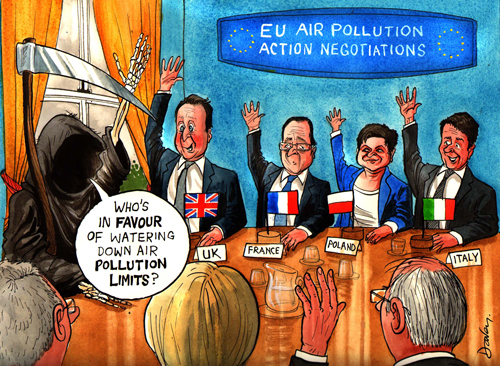In the middle of Paris stands a statue of a largely-forgotten figure from French history: Étienne Marcel, the fourteenth century holder of the office of ‘provost of the merchants’ – the medieval equivalent to today’s city mayor. Unlike Marcel, current Mayor Anne Hidalgo, hopes to leave her mark on Paris in an entirely invisible way.
More than four hundred years before the French revolution, Marcel was a powerful city leader who took on the royal establishment. Today, Hidalgo is part of a global trend of city mayors that are challenging national governments to do more on air pollution.
Last month Hidalgo joined the mayors of London, Barcelona, Milan, Copenhagen and other world cities in signing a “fossil free streets declaration”. Paris’s grand Hôtel de Ville recently played host to the European Commission’s Clean Air Forum.
Yet like many other cities, Paris has a problem with air pollution that it can’t solve alone.
The EEB’s Louise Duprez, who spoke in Paris, said that while it was a great opportunity for campaigners, experts, decision-makers and politicians to meet and discuss Europe’s air pollution crisis, the event itself exposed a missing link:
“This was an EU conference, hosted in a town hall; European and local actors taking the lead on air pollution. We have European protections that should help keep the air clean. We have many local governments and cities doing their part to deliver those protections. And then we have national governments failing to do their part.”
In fact, Duprez explains, national governments have consistently intervened to water down proposed new EU laws that could have delivered cleaner air and healthier streets for all Europeans:
“When the most recent air legislation was being discussed in Brussels, it was national governments that pushed up the limits, weakened the requirements and even insisted that some dangerous pollutants were removed from the scope of the law entirely.”

While the European Commission is sometimes criticised for not doing enough to ensure EU air pollution rules are respected, the fact that legal limits are being breached in more than 130 cities in 23 countries has not gone unnoticed in Brussels and legal proceedings have been launched against five big countries.
Earlier this year, Bulgaria was the first country to be judged to be failing to act quickly enough to improve air quality; a ruling that the EEB described as just ‘the tip of the iceberg’. Further such rulings are expected next year, while the same law has already successfully been used to sue the British government on two occasions.
Meanwhile, many cities are taking action to reduce pollution by banning or imposing extra charges on the worst polluters, pedestrianising city-centre areas and encouraging the use of electric vehicles.
According to Duprez, the lack of action by national governments is particularly problematic when it comes to what she calls one of the “invisible” causes of air pollution: farming.
“On certain days as many as 60% of the smallest most dangerous fine particles in the Parisian air are the result of ammonia emissions from agriculture. City mayors may be able to ban cars and clean up busses, but there’s nothing they can do about what farmers are up to outside the city limits.”
The lack of public awareness about the effects of animal waste and fertilisers on city air has led to action being taken against more apparent sources of pollution, like transportation and industry.
Despite the existence of simple, affordable and effective methods that can reduce agricultural emissions, farmers have failed to change their practices to reduce air pollution. Duprez says it’s now time for national laws that would change this.
“Where national governments have passed laws, like in the Netherlands, ammonia emissions from agriculture have dropped significantly. This doesn’t mean picking on small farmers as 80% of emissions come from just 10% of the biggest farms. Perhaps worryingly it’s only the ‘missing link’ that can tackle the ’invisible source’!”
In the meantime, while cities like Paris wait for national lawmakers and big farmers to catch up, they continue to focus on the sources of pollution they can take on.
As delegates left the clean air conference and escaped into the Paris night, they may have passed that statue of the provost of the merchants; Marcel, on horseback looks down at the Seine from in front of the Hôtel de Ville. Under Hidalgo’s leadership the river bank below has been transformed from a busy traffic-choked highway into a three-kilometre long park, with no cars anywhere to be seen.
Sadly for Marcel he was eventually chased to his death by an angry royalist mob. The people of Paris can only hope that Mayor Hidalgo has more luck as she continues her battle to end the reign of cars in the French capital.


